CCNA 1 Chapter 5 Exam Answers
- Refer to the exhibit. PC1 issues an ARP request because it needs to send a packet to PC2. In this scenario, what will happen next?
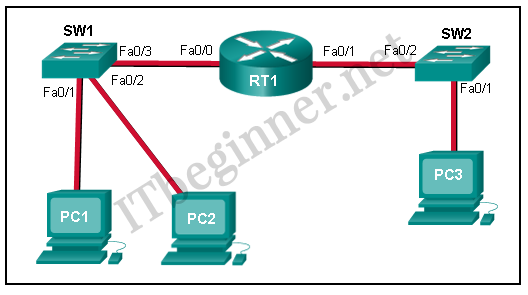
- PC2 will send an ARP reply with its MAC address.
- RT1 will send an ARP reply with its Fa0/0 MAC address.
- RT1 will send an ARP reply with the PC2 MAC address.
- SW1 will send an ARP reply with the PC2 MAC address.
- SW1 will send an ARP reply with its Fa0/1 MAC address.
- What statement describes Ethernet?
- It defines the most common LAN type in the world.
- It is the required Layer 1 and 2 standard for Internet communication.
- It defines a standard model used to describe how networking works.
- It connects multiple sites such as routers located in different countries.
- Which two statements describe features or functions of the logical link control sublayer in Ethernet standards? (Choose two.)
- Logical link control is implemented in software.
- Logical link control is specified in the IEEE 802.3 standard.
- The LLC sublayer adds a header and a trailer to the data.
- The data link layer uses LLC to communicate with the upper layers of the protocol suite.
- The LLC sublayer is responsible for the placement and retrieval of frames on and off the media.
- What statement describes a characteristic of MAC addresses?
- They must be globally unique.
- They are only routable within the private network.
- They are added as part of a Layer 3 PDU.
- They have a 32-bit binary value.
- Refer to the exhibit. A switch with a default configuration connects four hosts. The ARP table for host A is shown. What happens when host A wants to send an IP packet to host D?
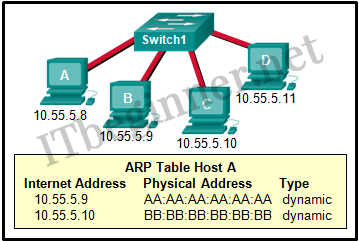
- Host A sends an ARP request to the MAC address of host D.
- Host D sends an ARP request to host A.
- Host A sends out the packet to the switch. The switch sends the packet only to the host D, which in turn responds.
- Host A sends out a broadcast of FF:FF:FF:FF:FF:FF. Every other host connected to the switch receives the broadcast and host D responds with its MAC address.
- Which statement is true about MAC addresses?
- MAC addresses are implemented by software.
- A NIC only needs a MAC address if connected to a WAN.
- The first three bytes are used by the vendor assigned OUI.
- The ISO is responsible for MAC addresses regulations.
- Which destination address is used in an ARP request frame?
- 0.0.0.0
- 255.255.255.255
- FFFF.FFFF.FFFF
- 127.0.0.1
- 01-00-5E-00-AA-23
- What addressing information is recorded by a switch to build its MAC address table?
- the destination Layer 3 address of incoming packets
- the destination Layer 2 address of outgoing frames
- the source Layer 3 address of outgoing packets
- the source Layer 2 address of incoming frames
- Refer to the exhibit. The exhibit shows a small switched network and the contents of the MAC address table of the switch. PC1 has sent a frame addressed to PC3. What will the switch do with the frame?
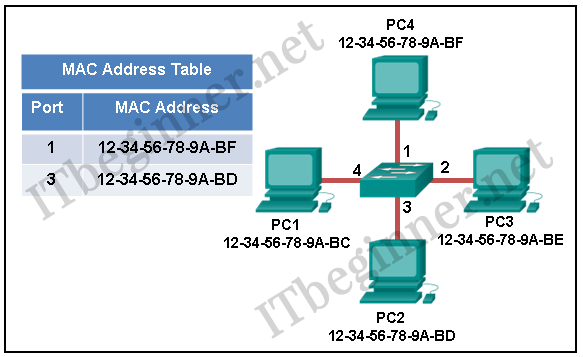
- The switch will discard the frame.
- The switch will forward the frame only to port 2.
- The switch will forward the frame to all ports except port 4.
- The switch will forward the frame to all ports.
- The switch will forward the frame only to ports 1 and 3.
- Which switching method uses the CRC value in a frame?
- cut-through
- fast-forward
- fragment-free
- store-and-forward
- What is auto-MDIX?
- a type of Cisco switch
- an Ethernet connector type
- a type of port on a Cisco switch
- a feature that detects Ethernet cable type
- What happens to runt frames received by a Cisco Ethernet switch?
- The frame is dropped.
- The frame is returned to the originating network device.
- The frame is broadcast to all other devices on the same network.
- The frame is sent to the default gateway.
- What are the two sizes (minimum and maximum) of an Ethernet frame? (Choose two.)
- 56 bytes
- 64 bytes
- 128 bytes
- 1024 bytes
- 1518 bytes
- True or False?
When a device is sending data to another device on a remote network, the Ethernet frame is sent to the MAC address of the default gateway.- true
- false
- The ARP table in a switch maps which two types of address together?
- Layer 3 address to a Layer 2 address
- Layer 3 address to a Layer 4 address
- Layer 4 address to a Layer 2 address
- Layer 2 address to a Layer 4 address
- Refer to the exhibit. The switches are in their default configuration. Host A needs to communicate with host D, but host A does not have the MAC address for its default gateway. Which network hosts will receive the ARP request sent by host A?
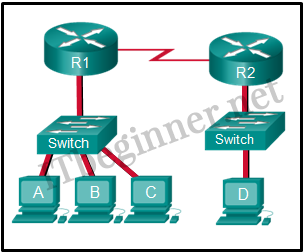
- only host D
- only router R1
- only hosts A, B, and C
- only hosts A, B, C, and D
- only hosts B and C
- only hosts B, C, and router R1
- Which statement describes the treatment of ARP requests on the local link?
- They must be forwarded by all routers on the local network.
- They are received and processed by every device on the local network.
- They are dropped by all switches on the local network.
- They are received and processed only by the target device.
- What are two potential network problems that can result from ARP operation? (Choose two.)
- Manually configuring static ARP associations could facilitate ARP poisoning or MAC address spoofing.
- On large networks with low bandwidth, multiple ARP broadcasts could cause data communication delays.
- Network attackers could manipulate MAC address and IP address mappings in ARP messages with the intent of intercepting network traffic.
- Large numbers of ARP request broadcasts could cause the host MAC address table to overflow and prevent the host from communicating on the network.
- Multiple ARP replies result in the switch MAC address table containing entries that match the MAC addresses of hosts that are connected to the relevant switch port.
- Fill in the blank.
A collision fragment, also known as a RUNT frame, is a frame of fewer than 64 bytes in length. - Fill in the blank.
On a Cisco switch, port-based memory buffering is used to buffer frames in queues linked to specific incoming and outgoing ports. - Fill in the blank.
ARP spoofing is a technique that is used to send fake ARP messages to other hosts in the LAN. The aim is to associate IP addresses to the wrong MAC addresses. - Match the characteristic to the forwarding method. (Not all options are used.)
- Question
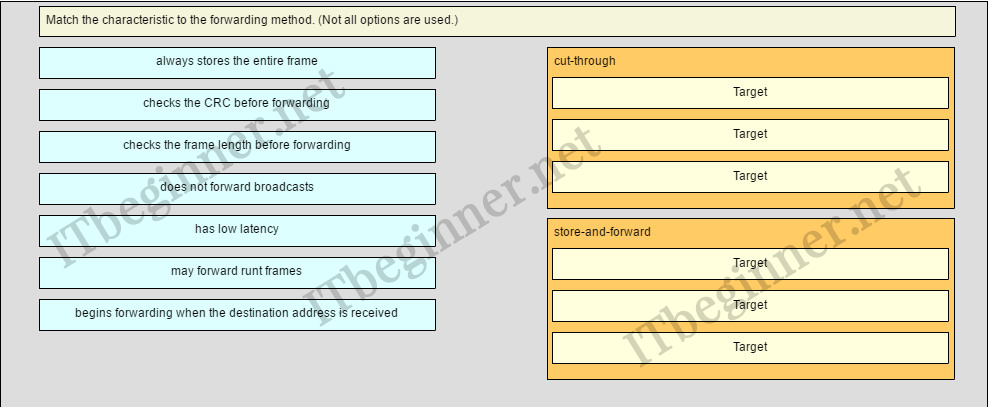
- Answer
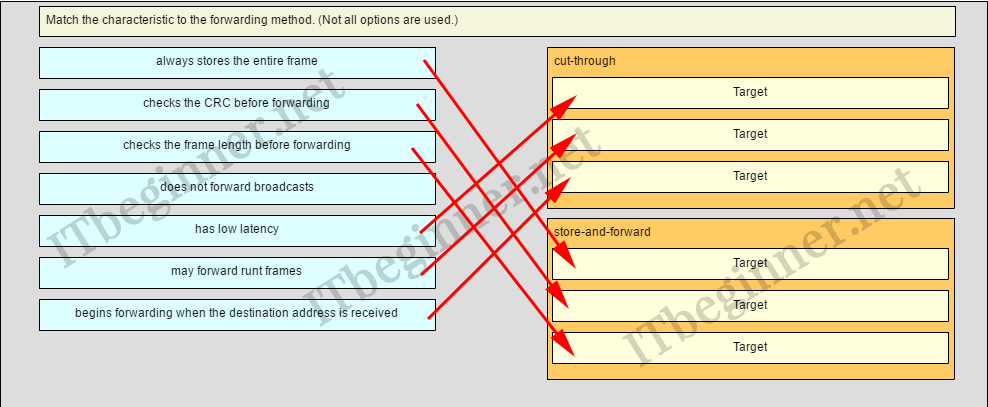
- Question
